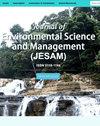Ultrasound-microwave Assisted Extraction (UMAE) of Andrographolide from Sinta (Andrographis paniculata) with its Bioactivity Assessment
IF 0.3
4区 环境科学与生态学
Q4 ENVIRONMENTAL SCIENCES
Journal of Environmental Science and Management
Pub Date : 2020-12-27
DOI:10.47125/jesam/2020_sp1/01
引用次数: 3
Abstract
Andrographolide (AG) is known to possess some pharmacological properties such as anti-inflammatory, antioxidant, anti-dengue, anti-tumor and anti-tuberculosis. Green extraction techniques such as ultrasound and microwave have shown the effectiveness in extracting high purity AG from Andrographis paniculata or Sinta. Ultrasound-assisted extraction (UAE), which operates at non-thermal conditions, prevents the thermal degradation of AG while microwave-assisted extraction (MAE) allows an increased extraction yield. This study aimed to determine the effect of sequential ultrasound- microwave-assisted extraction (UMAE) in the yield of AG and its bioactivity assessment. The UAE obtained its highest AG yield of 539.24 mg L-1 at 10 minutes sonication time and MAE with 781.65 mg L-1 at 5 minutes irradiation time with 420 W microwave power. The UMAE obtained the highest AG yield of 1,066.49 mg L-1 when sequentially exposed to 10 minutes sonication and 10 min irradiation with a microwave power of 280 W. Cytotoxic activity testing of Sinta extract containing AG from UMAE confirmed a lethal concentration (LC50) with value at 76.02 mg L-1. Furthermore, it has an intermediate susceptibility to Escherichia coli but resistant to both Bacillus clausii and Klebsiella spp., highlighting the potential of its valuable medicinal applications.超声波-微波辅助提取穿心莲内酯及其生物活性评价
穿心莲内酯(AG)具有抗炎、抗氧化、抗登革热、抗肿瘤和抗结核病等药理特性。超声波和微波等绿色提取技术已显示出从穿心莲或仙桃中提取高纯度AG的有效性。在非热条件下操作的超声辅助提取(UAE)可以防止AG的热降解,而微波辅助提取(MAE)可以提高提取率。本研究旨在确定连续超声-微波辅助提取(UMAE)对AG产量的影响及其生物活性评估。阿联酋在10分钟的超声处理时间内获得了最高的AG产量539.24 mg L-1,在5分钟的微波功率照射时间内获得的MAE产量781.65 mg L-1。当用280W的微波功率依次暴露于10分钟的超声处理和10分钟的辐射时,UMAE获得了1066.49 mg L-1的最高AG产量。对来自UMAE的含有AG的辛塔提取物的细胞毒性活性测试证实了致死浓度(LC50),其值为76.02 mg L-1。此外,它对大肠杆菌具有中等易感性,但对克劳氏芽孢杆菌和克雷伯菌均具有耐药性。这突出了其有价值的药用潜力。
本文章由计算机程序翻译,如有差异,请以英文原文为准。
求助全文
约1分钟内获得全文
求助全文
来源期刊

Journal of Environmental Science and Management
ENVIRONMENTAL SCIENCES-
CiteScore
0.90
自引率
0.00%
发文量
10
审稿时长
2 months
期刊介绍:
The Journal of Environmental Science and Management (JESAM) is an international scientific journal produced semi-annually by the University of the Philippines Los Baños (UPLB).
JESAM gives particular premium to manuscript submissions that employ integrated methods resulting to analyses that provide new insights in environmental science, particularly in the areas of:
environmental planning and management;
protected areas development, planning, and management;
community-based resources management;
environmental chemistry and toxicology;
environmental restoration;
social theory and environment; and
environmental security and management.
 求助内容:
求助内容: 应助结果提醒方式:
应助结果提醒方式:


